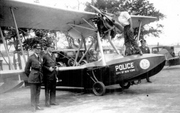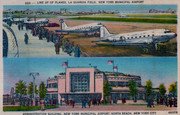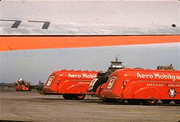Laguardia Airport history:
The airport site was first occupied by the Gala Amusement Park, a popular destination owned by the Steinway family. In 1929, the park was transformed into a 105-acre private flying field and first named Glenn H. Curtiss Airport after aviation pioneer Glenn H. Curtiss, and then re-named North Beach Airport.
In 1937, New York City took over the airport and enlarged the grounds with the purchase of adjoining land and by filling in 357 acres of waterfront along the east side. In 1939, it re-opened with a new name, New York Municipal Airport-LaGuardia Field. The airport was leased to the Port Authority in 1947.
(from PANY history)
FDNY Airport Crash Unit 31 was organized to protect the new Laguardia Airport in 1946. Primary dutry was to extinguish fire and lend aid for emergencies related to aircraft entering or leaving the airport. Equipment included a Sanitation Department sprinkler and three Army fire trucks. Unit established fre protection system and procedures for airport, responded to major crash in which they saved many lives and stayed in service until disbanded and responsibilities turned over to Port Authority.
ACU 31 approx 1946:

Fire Class Truck Class No 155 - US Army:
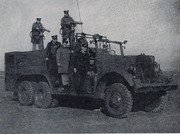
Tank capacity 1000 gal; 21 tons; 2 motors - driving and pumping; supplied 3 3/4 in lines; ; 2 deck guns; foam units; truck company tools
http://www.armyfiretrucks.com/155%20page.htm
Army Fire Truck Class No 125:
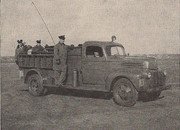
International chassis; Bean pump; supplied 3 3/4 in 100 ft handlines (2 water, 1 foam); truck tools
Army Fire Truck Class No 125:
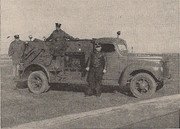
Ford chassis; Bean pump; supplied 3 3/4 in 100 ft handlines (2 water, 1 foam); truck tools
http://www.armyfiretrucks.com/125%20page.htm
(Info from WNYF)
The airport site was first occupied by the Gala Amusement Park, a popular destination owned by the Steinway family. In 1929, the park was transformed into a 105-acre private flying field and first named Glenn H. Curtiss Airport after aviation pioneer Glenn H. Curtiss, and then re-named North Beach Airport.
In 1937, New York City took over the airport and enlarged the grounds with the purchase of adjoining land and by filling in 357 acres of waterfront along the east side. In 1939, it re-opened with a new name, New York Municipal Airport-LaGuardia Field. The airport was leased to the Port Authority in 1947.
(from PANY history)
FDNY Airport Crash Unit 31 was organized to protect the new Laguardia Airport in 1946. Primary dutry was to extinguish fire and lend aid for emergencies related to aircraft entering or leaving the airport. Equipment included a Sanitation Department sprinkler and three Army fire trucks. Unit established fre protection system and procedures for airport, responded to major crash in which they saved many lives and stayed in service until disbanded and responsibilities turned over to Port Authority.
ACU 31 approx 1946:

Fire Class Truck Class No 155 - US Army:

Tank capacity 1000 gal; 21 tons; 2 motors - driving and pumping; supplied 3 3/4 in lines; ; 2 deck guns; foam units; truck company tools
http://www.armyfiretrucks.com/155%20page.htm
Army Fire Truck Class No 125:

International chassis; Bean pump; supplied 3 3/4 in 100 ft handlines (2 water, 1 foam); truck tools
Army Fire Truck Class No 125:

Ford chassis; Bean pump; supplied 3 3/4 in 100 ft handlines (2 water, 1 foam); truck tools
http://www.armyfiretrucks.com/125%20page.htm
(Info from WNYF)

